Tag: search
Find food and give back with Google
by Philipp Schindler on Nov.19, 2021, under 3D Models, Argentina, Australia, Brazil, California, Denmark, England, Germany, Google Earth News, Google Earth Tips, Google Sky, Google maps, Hawaii, Indonesia, Ireland, Italy, Japan, Kenya, Mexico, Natural Landmarks, Netherlands, Sightseeing, Street Views, USA
In Google’s early days, around this time every year, a group of us would run to Costco and buy supplies to take to Bay Area food banks and pantries. It was a grassroots effort that was scrappy and meaningful — and it introduced a lot of Googlers to how rewarding giving back can be. It made me want to learn what more we could do to have an even bigger impact.
Inspired by our small and mighty food donation operation, I became a passionate supporter of Second Harvest Food Bank in Silicon Valley. And with guidance from food assistance experts, we established a dedicated team at Google in 2020 to work on tackling issues of food waste and food insecurity. Too many families are having to make difficult decisions no one should be forced to make: paying rent, bills, healthcare costs — or keeping food on their table. These challenges have only been compounded by the COVID-19 crisis, which has left more than 54 million working Americans struggling to find a meal. That’s nearly 16% of the country.
Google co-founder Larry Page once said "people are starving in the world not because we don't have enough food. It's because we're not yet organized to solve that problem." The United Nations Food and Agriculture Organization (UNFAO) reports that the world produces more than we need to feed every person on this planet. This isn’t a problem of supply, it’s a problem of distribution. And while solving this issue will require work from government, businesses, nonprofits and individuals working together, one way Google can help is to give people easy access to the information they need, when they need it.
Helping people find food pantries
When you look at Google Search trends, you can see that searches for "food bank" and “food pantry” spike during the month of November.
Food banks have always been critical to making sure people have regular access to nutritious food, but the ongoing pandemic has drastically increased their role as a crucial lifeline in so many communities. With the need for their services doubling or even tripling in some areas, we want to make sure that the people who need them most can find them.
That’s why we’ve launched a new initiative to expand the information about food banks and pantries in Google Search and Maps. We’ve augmented existing coverage with data from two initial nonprofit partners: WhyHunger and Hunger Free America, and we’ve added information to make sure people searching for food support can find what they need. These changes are being made directly in Google Maps so food banks, food pantries and soup kitchens can focus on what matters most — getting people food.
Still, some of these locations don’t yet have websites or phone numbers available on Google. So over the last two months, we've worked to update this information in Search and Maps, making 85,000 plus calls to verify local food banks and pantries. These efforts will continue through the holidays.
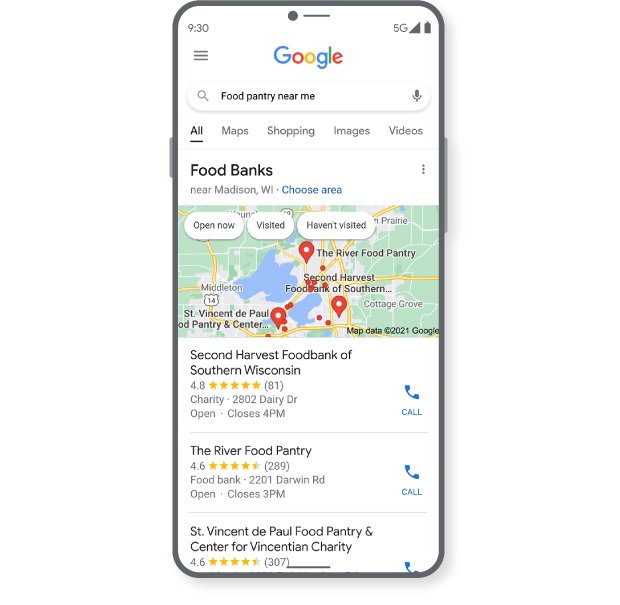
We’ve also developed new Google Business Profile features specifically for food banks, pantries and soup kitchens. They can now provide details on their profile, like whether an appointment is needed, if there are eligibility requirements to receive food and what languages are spoken. They can also add information about their services, like whether prepared meals are available or if grocery delivery is an option. Additionally, pantries can specify whether they’re accepting new volunteers or soliciting food or monetary donations.
Helping people access benefits
Beyond working with food pantries, we’re also helping people use Search to find out how to get and use food assistance benefits.
Federal programs like the Supplemental Nutrition and Assistance Program (SNAP) feed more than 40 million Americans each year. We heard from users that information about these programs is often hard to find, especially for people who are using them for the first time. Today, if you search on Google for “SNAP benefits,” or the name of your local SNAP program, you’ll find direct links to each state’s eligibility guidelines and application process, including contact information for local food assistance agencies.
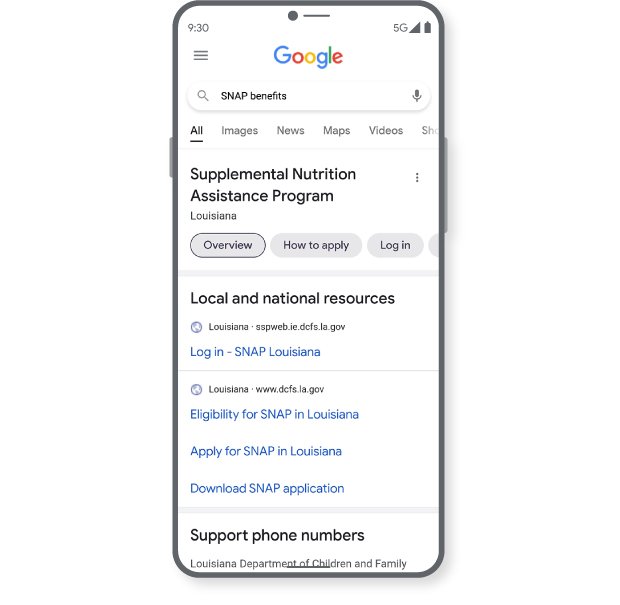
Once approved, many people use Electronic Benefits Transfer cards (also known as EBT) to pay for their groceries. Now, if you search for “grocery stores that accept EBT” you can easily find USDA-approved stores that accept this form of payment — saving time and potential confusion.
Supporting hunger relief organizations – and the communities they serve
I’m also proud to announce that we’re contributing financial support as well. Since the COVID-19 crisis began, Googlers have stepped up – giving more than $22 million in personal donations and company-match to hunger relief organizations in the U.S. Today, Google is contributing an additional $2 million in support ($1 million in cash funding and $1 million in donated ads from Google.org) to 20 food banks, pantries and innovative hunger relief organizations across the country.
There is no easy solution to these large-scale challenges that face our communities, but I’m hopeful that increasing access to information about local food support programs and services can help. Our teams are hard at work and committed to building new tools and features that support economic recovery in the U.S. – and around the world – as we weather the COVID-19 crisis. And I personally am really looking forward to getting back to sorting and distributing food with my family at our local food bank.
You can make an impact by volunteering your time, making a donation, using your voice, or a combination of each — there are a number of ways we can all give back. If you need a place to start, you can donate to the largest national network of food banks, Feeding America. Or you can get involved locally: just search for your nearest food pantry on Google and contact them to see what they need. And if you know someone who might need food assistance, you can simply help by sharing resources. Spreading the word not only about what you’re doing to help, but why can make a huge difference.
Foster meaningful conversations with customers on Google
by Anita Yuen on Nov.04, 2021, under 3D Models, Argentina, Australia, Brazil, California, Denmark, England, Germany, Google Earth News, Google Earth Tips, Google Sky, Google maps, Hawaii, Indonesia, Ireland, Italy, Japan, Kenya, Mexico, Natural Landmarks, Netherlands, Sightseeing, Street Views, USA
Whether it’s searching for the perfect gift or looking for a contractor to remodel that bathtub, consumers are increasingly turning to calls and chat to interact with merchants. People want to communicate with businesses to help them make more informed decisions, and this trend is continuously accelerating. That’s why we’re introducing new features that’ll help business owners make the most of their interactions with customers on Google Search and Maps.
Learn more about the calls you receive from Google
People often value the immediacy and personal connection of a phone call, and we know this directly impacts merchants’ businesses. For example, Nedra Flansberg, the owner of Posh Brides and Grooms based in Carlsbad CA, told us that 50% of her customers come from Google. To help build connections between customers and millions of merchants like Nedra, we’re launching call history for all U.S. and Canadian merchants with verified Business Profiles. With call history, you can easily see which inbound customer calls came from your Business Profile and review helpful analytics on inbound call performance.
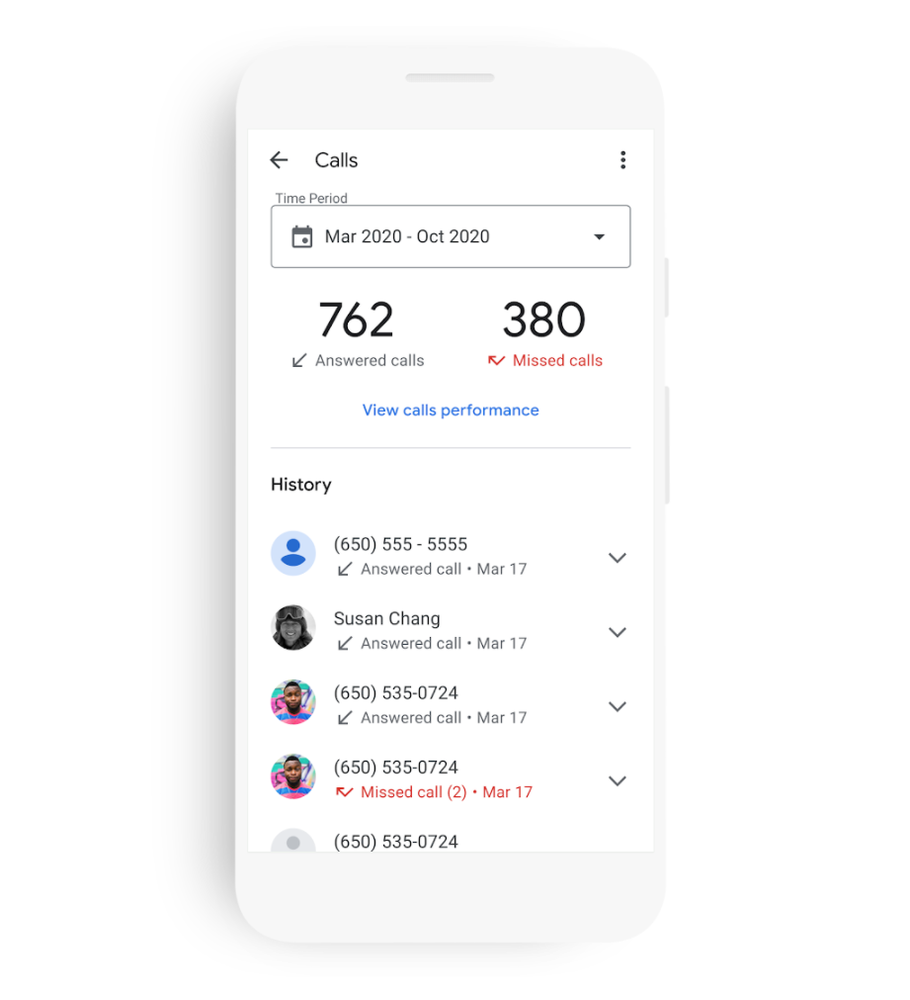
Quickly respond to customers on your Business Profile
Another valuable way consumers engage with merchants is by chatting with them. More and more people are turning to chat conversations with merchants of all sizes, ranging from small businesses to global merchants like Levi’s. With business messaging, Levi’s was able to resolve 30x more store related questions and saw a 31% increase in product related conversations. Merchants tell us they want to improve their interactions with customers, so we’re announcing a few new features to help them do just that.
Last year, we added functionality so you can chat with customers directly on Google Maps. Now, you can also see and respond to messages right from your Business Profile on Google Search.
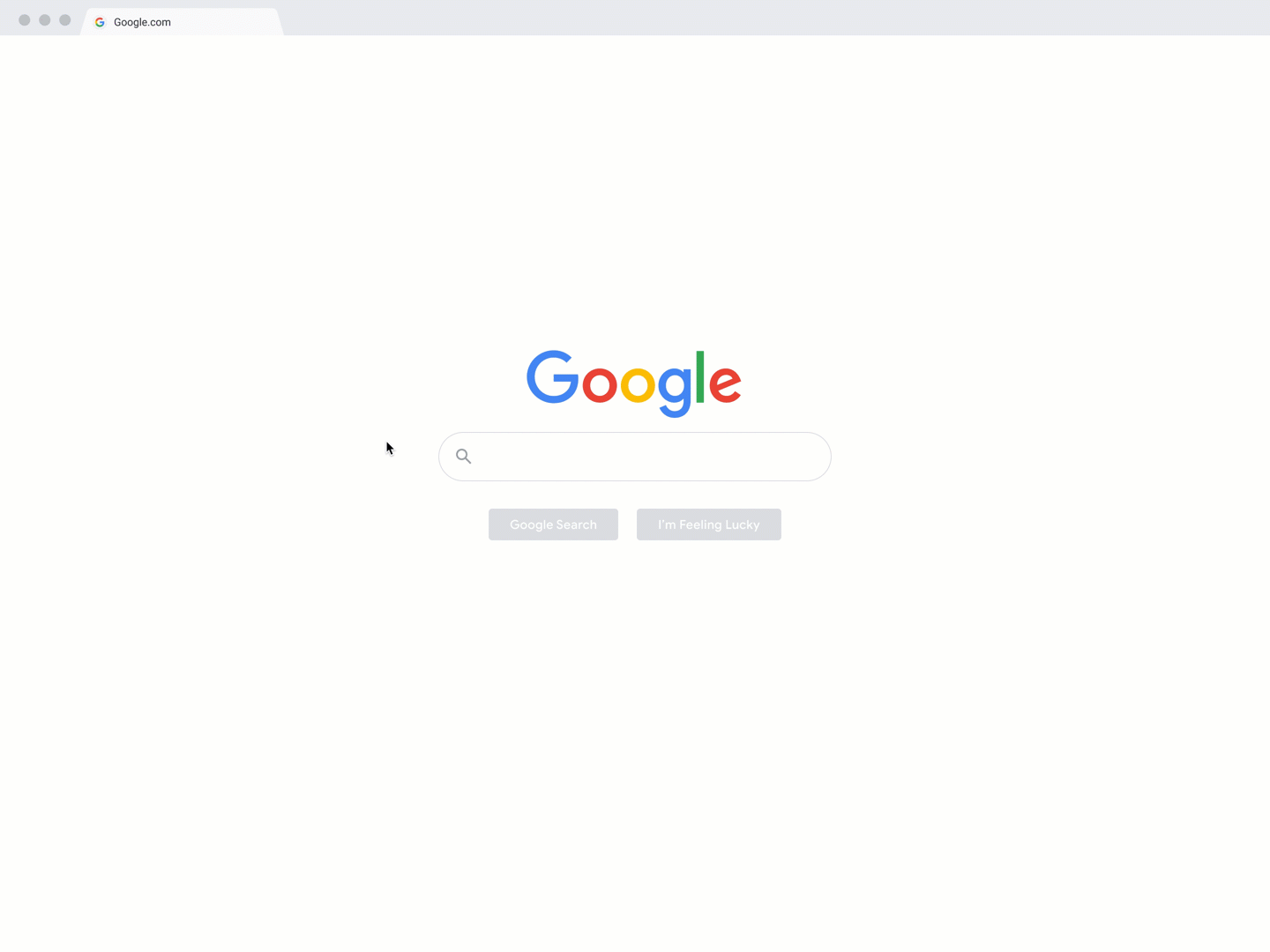
It's also helpful to know the recipient got your message on chat. With read receipts, both parties know whether their messages were seen. This feature is launching for all Business Profile merchants this month, further enriching the chat experience for customers and businesses.
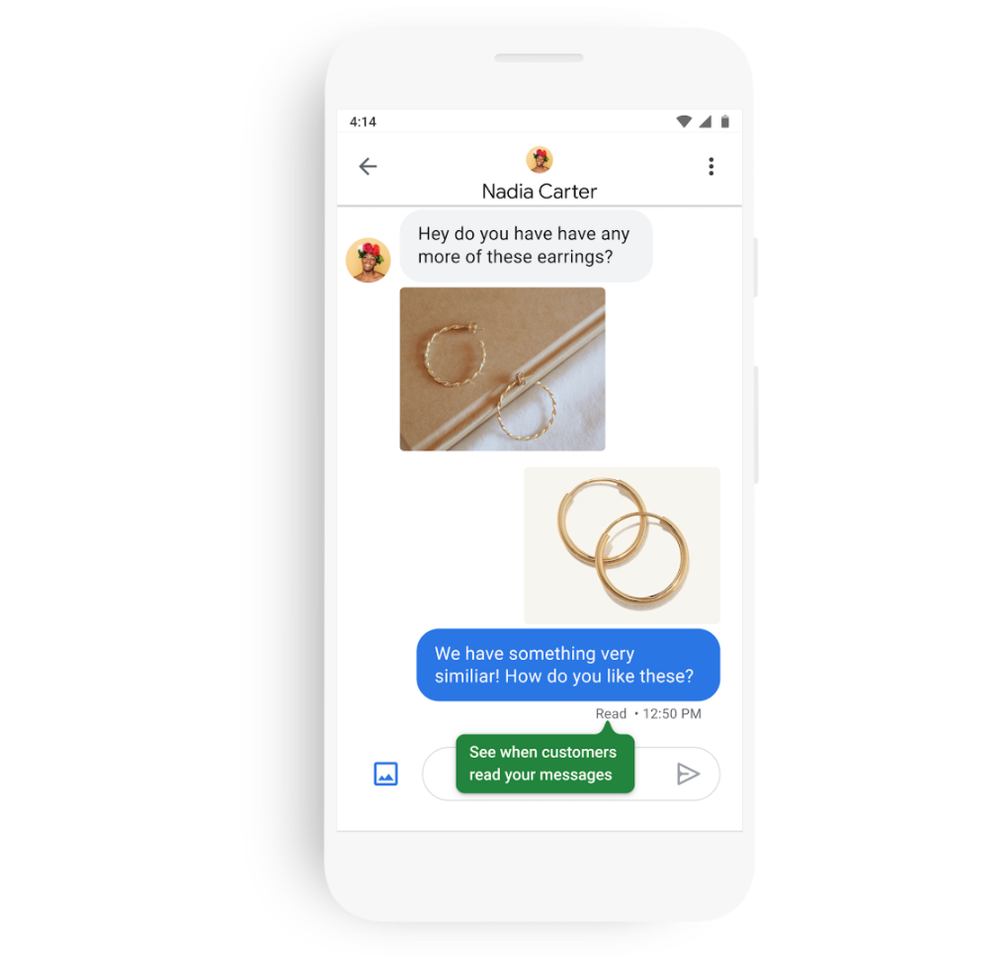
As businesses prepare for another busy holiday season, and customers increasingly turn to calls and chat to interact with businesses, we look forward to helping foster even more meaningful interactions and giving merchants more tools to succeed.
Welcome to spooky season
by Jack O'Lantern on Oct.07, 2021, under 3D Models, Argentina, Australia, Brazil, California, Denmark, England, Germany, Google Earth News, Google Earth Tips, Google Sky, Google maps, Hawaii, Indonesia, Ireland, Italy, Japan, Kenya, Mexico, Natural Landmarks, Netherlands, Sightseeing, Street Views, USA
The smell of pumpkin spice is in the air, which means it’s about time to bust out the costumes, stock up on some candy and carve a pumpkin or two. If you need a little inspiration, look no further than these spooky Search and Maps trends we collected.
Pumpkin to Search about
Whether you plan on spending the day watching Halloween classics or trick-or-treating in a clever costume, we’ve got Search trends to give you some ideas. (Be sure to also check out our annual Frightgeist for the most-searched Halloween costumes across the U.S.)
Most-searched Halloween movies over the past week in the U.S.
- Halloween (1978)
- Friday the 13th
- Hocus Pocus
- A Nightmare on Elm Street
- Halloweentown
Already seen these? Grab the popcorn (or the candy corn) and virtually explore the filming locations of your favorite cult classics on Google Earth.
Moving on to costumes! Picking the right outfit — whether it’s just for you, a group or your furry friend — is important. Here are the costume searches that have been trending this week in the U.S.
Trending Halloween costumes:
- Squid Game
- Gorilla
- Britney Spears
- Carnage
- Venom
Trending couples costumes:
- Trixie and Timmy Turner
- Bonnie and Clyde
- Skid and Pump
- Mr. and Mrs. Smith
- Cosmo and Wanda
Trending dog costumes:
- Squid Game
- Race car
- Vampire
- Donkey
- Lobster
If you still aren’t sure what to wear, you can ask Google Assistant for some last-minute costume ideas, too. Just say "Hey Google, what should I be for Halloween?”
Maybe you’d prefer to boo-rowse aisles IRL without a crowd. We checked the most popular times on Google Maps to visit costume shops across the U.S. and found they’re at their busiest on Saturday and Sunday around 2 p.m., and least busy before 2 p.m. on Monday and Tuesday.
But, beware! Last-minute shoppers might be in for a scare. Google Maps searches for costume stores in the U.S. peaked on Halloween day last year — nearly doubling from the week before, and nearly tripling from October 10th. So get your costume and accessory shopping done early for the best chance of finding what you’re looking for.
For those interested in refreshments or snacks to follow all that trick-or-treating, you can see which Halloween drinks are being searched for by state. And of course, everyone has to know what their state prefers: candy corn or M&Ms?
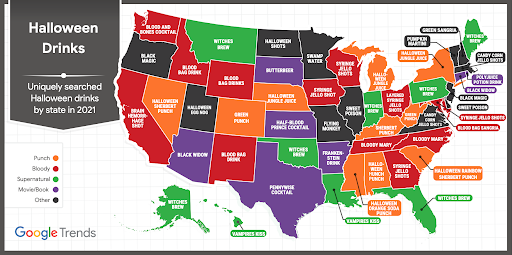
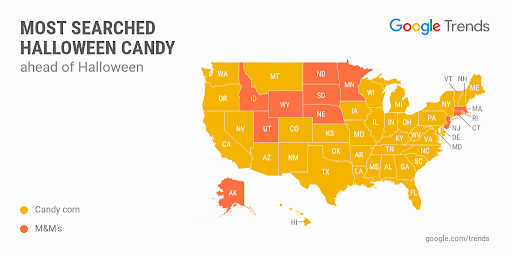
What unlocks a haunted house? A spoo-key
Of course, Halloween isn’t only about get-togethers and candy — some of us enjoy a little scare. Head over to the Google Maps guide to Halloween and check out Local Guide Kimbra Kasch's favorite spooky spots. And Kimbra should know: She grew up in a haunted house in Portland, Oregon!
Google Maps’ guide also has plenty of other places to discover for the fall festivities, so be sure to take a look.
How AI is making information more useful
by Prabhakar Raghavan on Sep.30, 2021, under 3D Models, Argentina, Australia, Brazil, California, Denmark, England, Germany, Google Earth News, Google Earth Tips, Google Sky, Google maps, Hawaii, Indonesia, Ireland, Italy, Japan, Kenya, Mexico, Natural Landmarks, Netherlands, Sightseeing, Street Views, USA
Today, there’s more information accessible at people’s fingertips than at any point in human history. And advances in artificial intelligence will radically transform the way we use that information, with the ability to uncover new insights that can help us both in our daily lives and in the ways we are able to tackle complex global challenges.
At our Search On livestream event today, we shared how we’re bringing the latest in AI to Google’s products, giving people new ways to search and explore information in more natural and intuitive ways.
Making multimodal search possible with MUM
Earlier this year at Google I/O, we announced we’ve reached a critical milestone for understanding information with Multitask Unified Model, or MUM for short.
We’ve been experimenting with using MUM’s capabilities to make our products more helpful and enable entirely new ways to search. Today, we’re sharing an early look at what will be possible with MUM.
In the coming months, we’ll introduce a new way to search visually, with the ability to ask questions about what you see. Here are a couple of examples of what will be possible with MUM.
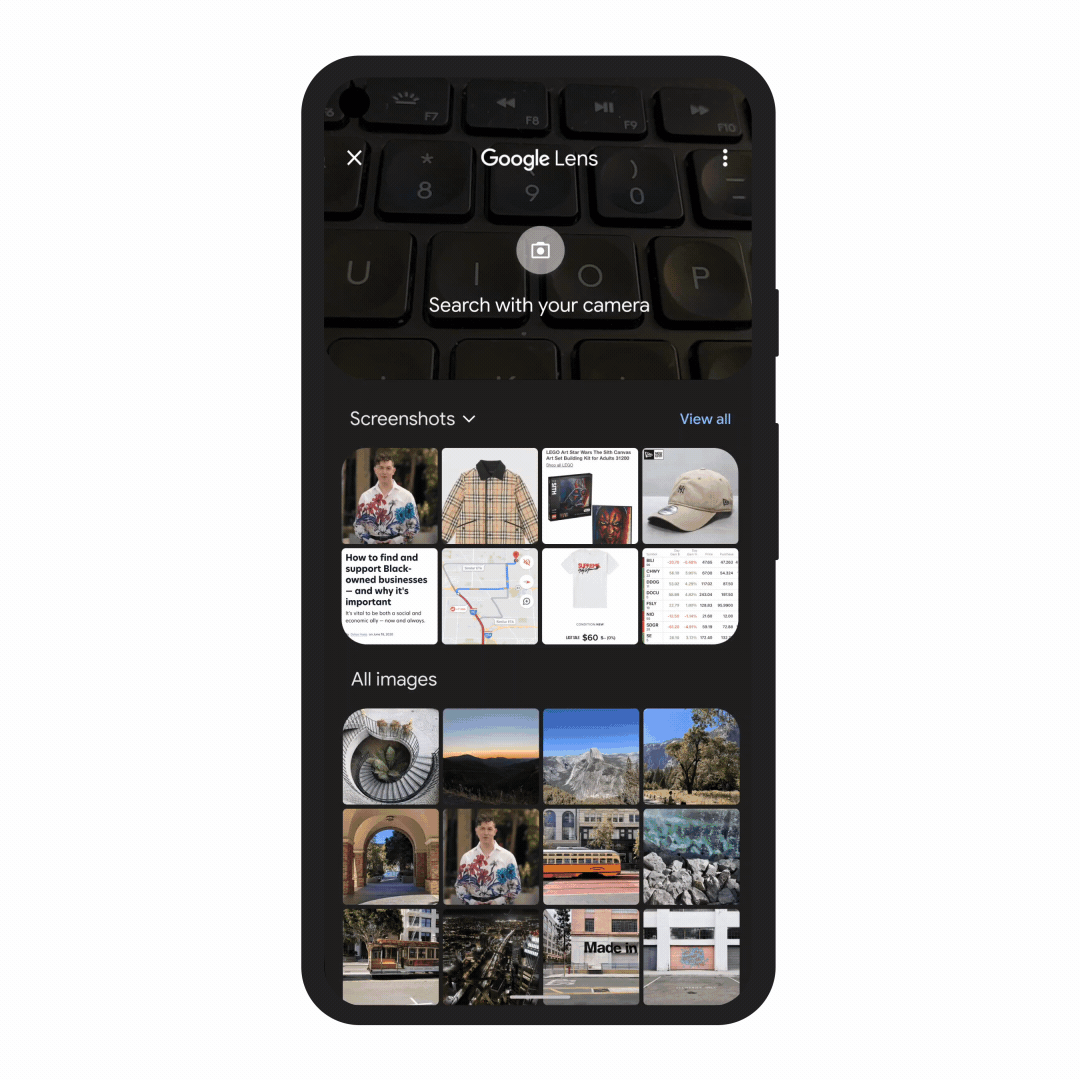
With this new capability, you can tap on the Lens icon when you’re looking at a picture of a shirt, and ask Google to find you the same pattern — but on another article of clothing, like socks. This helps when you’re looking for something that might be difficult to describe accurately with words alone. You could type “white floral Victorian socks,” but you might not find the exact pattern you’re looking for. By combining images and text into a single query, we’re making it easier to search visually and express your questions in more natural ways.

Some questions are even trickier: Your bike has a broken thingamajig, and you need some guidance on how to fix it. Instead of poring over catalogs of parts and then looking for a tutorial, the point-and-ask mode of searching will make it easier to find the exact moment in a video that can help.
Helping you explore with a redesigned Search page
We’re also announcing how we’re applying AI advances like MUM to redesign Google Search. These new features are the latest steps we’re taking to make searching more natural and intuitive.
First, we’re making it easier to explore and understand new topics with “Things to know.” Let’s say you want to decorate your apartment, and you’re interested in learning more about creating acrylic paintings.

If you search for “acrylic painting,” Google understands how people typically explore this topic, and shows the aspects people are likely to look at first. For example, we can identify more than 350 topics related to acrylic painting, and help you find the right path to take.
We’ll be launching this feature in the coming months. In the future, MUM will unlock deeper insights you might not have known to search for — like “how to make acrylic paintings with household items” — and connect you with content on the web that you wouldn’t have otherwise found.
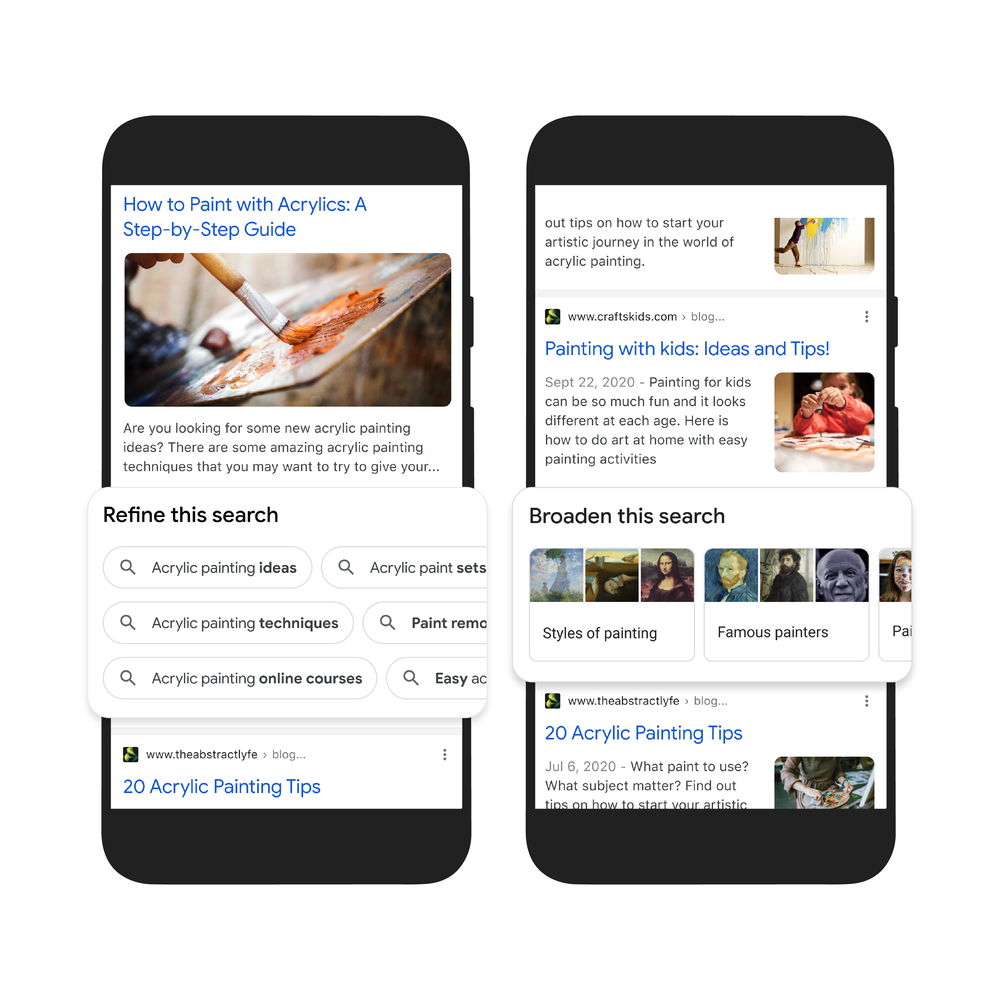
Second, to help you further explore ideas, we’re making it easy to zoom in and out of a topic with new features to refine and broaden searches.
In this case, you can learn more about specific techniques, like puddle pouring, or art classes you can take. You can also broaden your search to see other related topics, like other painting methods and famous painters. These features will launch in the coming months.

Third, we’re making it easier to find visual inspiration with a newly designed, browsable results page. If puddle pouring caught your eye, just search for “pour painting ideas" to see a visually rich page full of ideas from across the web, with articles, images, videos and more that you can easily scroll through.
This new visual results page is designed for searches that are looking for inspiration, like “Halloween decorating ideas” or “indoor vertical garden ideas,” and you can try it today.
Get more from videos
We already use advanced AI systems to identify key moments in videos, like the winning shot in a basketball game, or steps in a recipe. Today, we’re taking this a step further, introducing a new experience that identifies related topics in a video, with links to easily dig deeper and learn more.
Using MUM, we can even show related topics that aren’t explicitly mentioned in the video, based on our advanced understanding of information in the video. In this example, while the video doesn’t say the words “macaroni penguin’s life story,” our systems understand that topics contained in the video relate to this topic, like how macaroni penguins find their family members and navigate predators. The first version of this feature will roll out in the coming weeks, and we’ll add more visual enhancements in the coming months.
Across all these MUM experiences, we look forward to helping people discover more web pages, videos, images and ideas that they may not have come across or otherwise searched for.
A more helpful Google
The updates we’re announcing today don’t end with MUM, though. We’re also making it easier to shop from the widest range of merchants, big and small, no matter what you’re looking for. And we’re helping people better evaluate the credibility of information they find online. Plus, for the moments that matter most, we’re finding new ways to help people get access to information and insights.
All this work not only helps people around the world, but creators, publishers and businesses as well. Every day, we send visitors to well over 100 million different websites, and every month, Google connects people with more than 120 million businesses that don't have websites, by enabling phone calls, driving directions and local foot traffic.
As we continue to build more useful products and push the boundaries of what it means to search, we look forward to helping people find the answers they’re looking for, and inspiring more questions along the way.
Abriendo caminos: New pathways for Latino-owned businesses
by Ramiro Cavazos on Sep.28, 2021, under 3D Models, Argentina, Australia, Brazil, California, Denmark, England, Germany, Google Earth News, Google Earth Tips, Google Sky, Google maps, Hawaii, Indonesia, Ireland, Italy, Japan, Kenya, Mexico, Natural Landmarks, Netherlands, Sightseeing, Street Views, USA
Ver abajo versión en español
At the United States Hispanic Chamber of Commerce, which I have the honor to lead as president and CEO, helping Latino-owned businesses succeed is at the center of our mission. Our responsibility to the more than 4.7 million Latino-owned businesses and our growing network of 260 local chambers and business associations nationwide is to pursue and advocate for inclusive economic growth and development that build shared prosperity.
We represent the fastest-growing group of entrepreneurs in the U.S., and we don’t take that responsibility lightly. The number of Latino business owners has grown by 34% over the last 10 years compared to just 1% for all other businesses, according to a recent study by the Stanford Latino Entrepreneurship Initiative, and much of this growth has been driven by Latinas. These new businesses are invigorating, highlight our potential and are what motivates me everyday.
In 2020, with the arrival of the COVID-19 pandemic, our chambers became emergency rooms for small businesses. We quickly mobilized and awarded hundreds of thousands of dollars in grants directly to Latino owners and our local chambers to provide assistance. These funds were a lifeline for Latino businesses to keep the lights on, make payroll, rent and meet other critical needs.
We also provided technical assistance, established online resource hubs in English and in Spanish and graduated more than 200 Latino-owned small businesses through our accelerator program.
Last year was also our most active year in Washington, D.C. We raised $850 billion to provide assistance for our Latino small business members. We advocated for access to the Paycheck Protection Program (PPP) for both Latino-owned businesses and 501(c) (6) Chambers of Commerce.
As we take a moment to reflect on our progress to date, we have our eyes on the future. There is no denying that the world has dramatically changed, and we need to adapt and thrive, not just to survive. And technology is driving change forward faster than ever before.
We got a glimpse of the transformational power of technology through our partnership with Google last year. We collaborated to provide extra funding and Grow with Google curriculum support to 40 of our chambers across the country. Together, we trained 10,000 Latino small businesses and the initial results and impact we've seen is truly remarkable.
Google and the United States Hispanic Chamber of Commerce share a deep commitment to economic opportunity, development and advocacy for Latinos. This is why today, we are sharing that Google will be making a $5 million investment in Latino-owned businesses and community organizations. Together we are also unveiling a new Latino-owned attribute that will be available across Google Search, Maps and Shopping. All this is part of Google's $15 million investment in economic equity for Latinos.
Building more resilient Latino businesses
Today, we are deepening our partnership with Google with an additional investment that will allow us to create Grow with Google digital resource centers and train an additional 10,000 Latino business owners on how to use digital tools to grow their business. This work is critical to setting up Latino business owners for success for the long haul. These new skills, training and resources will help them be competitive in today's digital economy and allow us to help aspiring entrepreneurs to think digital-first.
Google.org is also providing funding to support the Latino Community Foundation's Entrepreneurship Fund, an initiative that strengthens Latino-led small businesses and micro-entrepreneurs across California. It will directly invest in 150+ micro-entrepreneurs to support the tireless work of street vendors, cleaning services, landscapers, childcare providers and other micro-entrepreneurs. For Latino-owned businesses, running a business is often a family affair, and the Entrepreneurship Fund will increase and improve the online presence for Latino-owned small restaurants through the creation of websites and social media accounts designed and managed by youth participating in tech skills building programs.
This is in addition to Google's ongoing support of nonprofits through $3 million in donated ads to Latino organizations. This includes the Hispanic Access Foundation, which uses Google.org's support to advertise internships for Latino college students, fundraise for DACA fee scholarships, and more — all in service of enabling more Latinos in the U.S. to achieve economic success.
Identify and buy from Latino-owned businesses
Today, we are partnering with Google to unveil a Latino-owned attribute that will be available on Search, Maps and Shopping, in the coming weeks, so businesses can easily identify as Latino-owned on Google. This update builds on the Black-owned, Veteran-owned and Women-owned business attributes, and is another way people can support diverse businesses across Google’s products and platforms.
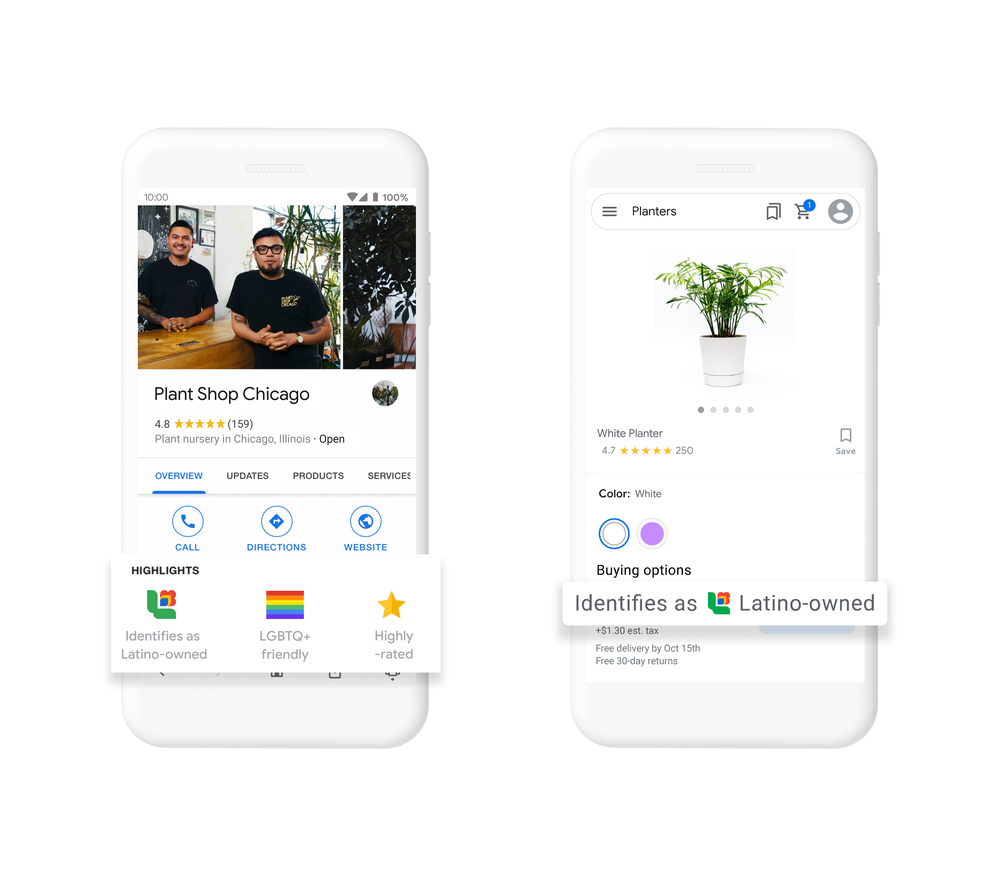
For more than 20 years, Google has been at the forefront of democratizing access for all — it's one of its core values. Underrepresented groups have been beneficiaries of that mission, which is still alive today. This is why we deeply believe Google's open platforms, digital training, tools and resources are critical to advancing economic equity for the Latino community.
Today's investments and product updates will provide our members, chambers and our communities a much needed boost. We are glad to help spotlight Latino-owned businesses in a new light, showcase our resilient spirit and invoke action. We are energized by our momentum and are eager to get back to business. I believe our future is bright - and today thanks to Google, it's a little brighter.
Abriendo caminos: Nuevos caminos para las empresas de propietarios latinos
Google y la Cámara de Comercio Hispana de los Estados Unidos (United States Hispanic Chamber of Commerce) se asocian para ofrecer un atributo de propietarios latinos en Búsqueda (Search), Maps, y Shopping, además de nuevo apoyo financiero y capacitación en habilidades para propietarios de empresas latinas y organizaciones sin fines de lucro.
En la Cámara de Comercio Hispana de los Estados Unidos, donde tengo el honor de dirigir como presidente y director ejecutivo, ayudar a las empresas latinas a tener éxito está al centro de nuestra misión. Nuestra responsabilidad con las más de 4.7 millones de empresas de propietarios latinos y nuestra creciente red de 260 cámaras locales y asociaciones comerciales en todo el país es buscar y abogar por el crecimiento y el desarrollo económico que construya la prosperidad compartida.
Representamos al grupo de emprendedores de más rápido crecimiento en los Estados Unidos y no nos tomamos esa responsabilidad a la ligera. El número de propietarios de negocios latinos ha crecido en un 34% en los últimos 10 años en comparación con solo el 1% de todos los demás negocios, según un estudio reciente de Stanford Latino Entrepreneurship Initiative, y gran parte de este crecimiento ha sido impulsado por latinas. Estos nuevos negocios son estimulantes, resaltan nuestro potencial y son lo que me motiva todos los días.
En 2020, con la llegada de la pandemia COVID-19, nuestras cámaras se convirtieron en salas de emergencia para pequeñas empresas. Rápidamente nos movilizamos y otorgamos cientos de miles de dólares en subvenciones directamente a pequeñas empresas de propietarios latinos y nuestras cámaras locales para brindar asistencia. Estos fondos fueron un salvavidas para las empresas latinas para mantener las luces encendidas, pagar nóminas, renta y satisfacer otras necesidades críticas.
También brindamos asistencia técnica, establecimos centros de recursos en línea en inglés y en español y graduamos a más de 200 pequeñas empresas latinas a través de nuestro programa acelerador de pequeñas empresas.
El año pasado también fue nuestro año más activo en Washington, D.C. Recaudamos $850 mil millones de dólares para brindar asistencia a nuestros miembros latinos de pequeñas empresas. Abogamos por el acceso al Programa de Protección de Cheques de Pago (PPP) tanto para las empresas propiedad de latinos como para las Cámaras de Comercio 501 (c) (6).
Mientras nos tomamos un momento para reflexionar sobre nuestro progreso hasta la fecha, tenemos la mirada puesta en el futuro. No se puede negar que el mundo ha cambiado drásticamente y que necesitamos adaptarnos y prosperar, no solo para sobrevivir. Y la tecnología está impulsando el cambio más rápido que nunca.
Pudimos vislumbrar el poder transformador de la tecnología a través de nuestra asociación con Google el año pasado. Colaboramos para proporcionar financiación adicional y curriculum de Grow with Google a 40 de nuestras cámaras en todo el país. Juntos, capacitamos a 10,000 pequeñas empresas latinas y los resultados iniciales y el impacto que hemos visto son realmente notables.
Google y la Cámara de Comercio Hispana de los Estados Unidos comparten un profundo compromiso con las oportunidades económicas, desarrollo y abogacía para latinos. Es por eso que hoy compartimos que Google realizará una inversión de $5 millones de dólares en la comunidad empresarial de propietarios latinos y organizaciones comunitarias. Juntos estamos presentando un nuevo atributo de propietarios latinos que estará disponible en la Búsqueda de Google, Maps y Shopping. Todo esto es parte de la inversión de $15 millones de dólares de Google en equidad económica para latinos.
Construyendo negocios latinos más resilientes
Hoy, estamos profundizando nuestra asociación con Google con una inversión adicional que nos permitirá crear centros de recursos digitales Grow with Google y capacitar a 10,000 propietarios de negocios latinos adicionales sobre cómo usar herramientas digitales para hacer crecer su negocio. Este trabajo es fundamental para que los empresarios latinos tengan éxito a largo plazo. Estas nuevas habilidades, capacitación y recursos los ayudarán a ser competitivos en la economía digital actual y nos permitirán ayudar a los aspirantes emprendedores a pensar primero en lo digital.
Google.org también está proporcionando fondos para apoyar el Fondo de Emprendimiento (Entrepreneurship Fund) del Latino Community Foundation, una iniciativa que fortalece a las pequeñas empresas y microempresarios liderados por latinos en todo California. Invertirá directamente en más de 150 microempresarios para apoyar el trabajo incansable de los vendedores ambulantes, servicios de limpieza, jardineros, proveedores de cuidado infantil y otros microempresarios. Para las empresas de propietarios latinos, administrar una empresa es a menudo un asunto familiar, y el Fondo de Emprendimiento aumentará y mejorará la presencia en línea de los pequeños restaurantes de propietarios latinos a través de la creación de sitios web y cuentas de redes sociales diseñadas y administradas por jóvenes que participan en programas que forman sus habilidades tecnológicas.
Esto, en adición al apoyo continuo de Google a las organizaciones sin fines de lucro a través de $3 millones de dólares en anuncios donados a organizaciones latinas. Esto incluye la Hispanic Access Foundation
https://hispanicaccess.org/
, que utiliza el apoyo de Google.org para anunciar prácticas para estudiantes universitarios latinos, recaudar fondos para becas que cubren los costos de DACA y más — todo al servicio de permitir que más latinos en los Estados Unidos logren el éxito económico.Identificar y comprar en empresas de propiedad de latinos
Hoy, nos asociamos con Google para anunciar un atributo de propietarios latinos que estará disponible en la Búsqueda, Maps y Shopping en las próximas semanas, para que las empresas puedan identificarse fácilmente como propietarios latinos en Google. Esta actualización se basa en los atributos de negocios Black-owned, Veteran-owned y Women-owned; y es otra manera la gente puede apoyar a diversas empresas a través de productos y plataformas de Google.
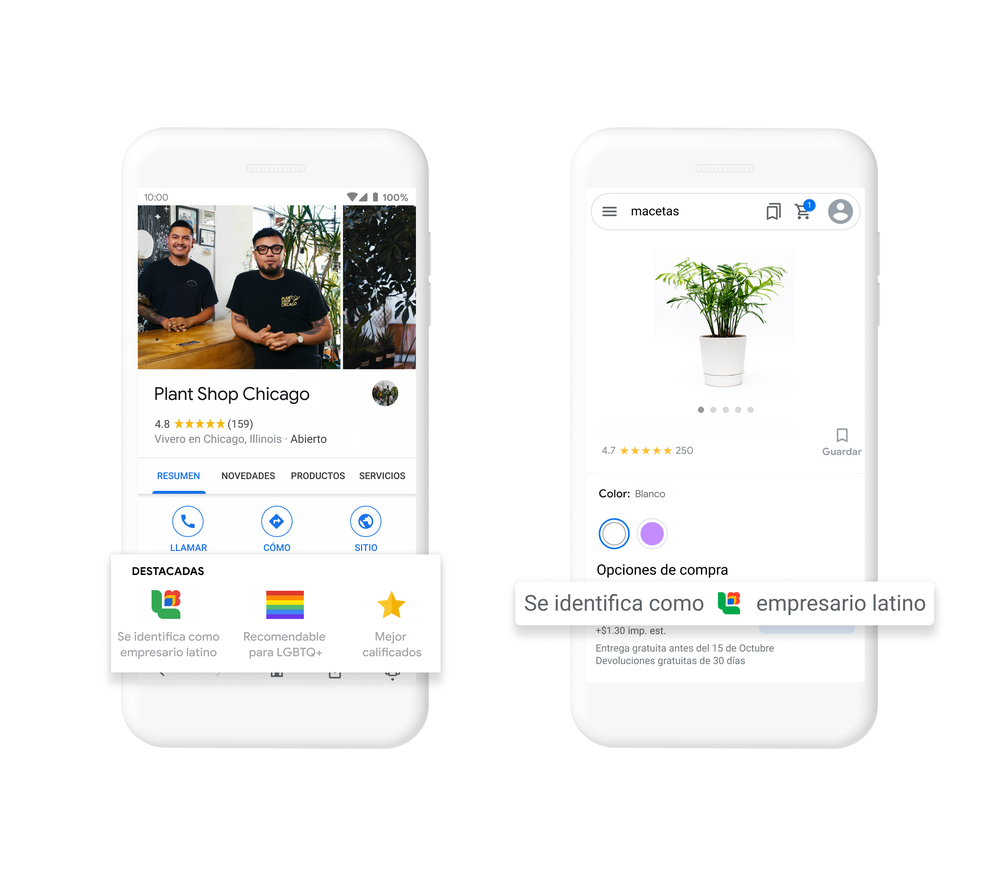
Durante más de 20 años, Google ha estado a la vanguardia de la democratización del acceso para todos — es uno de sus valores fundamentales. Los grupos subrepresentados se han beneficiado de esa misión, la cual continúa vigente hoy. Es por eso que creemos profundamente que las plataformas abiertas, la capacitación digital, las herramientas y los recursos de Google son fundamentales para promover la equidad económica para la comunidad latina.
Las inversiones de hoy y las actualizaciones de productos proporcionarán a nuestros miembros, cámaras y comunidades un impulso muy necesario. Nos complace ayudar a destacar las empresas de propietarios latinos bajo una nueva luz, mostrar nuestro espíritu resistente e invocar la acción. Nuestro impulso nos llena de energía y estamos ansiosos por volver al trabajo. Creo que nuestro futuro es brillante, y hoy, gracias a Google, es un poco más brillante.
Now it’s easier to show what your business offers on Google
by David Rohan on Jun.17, 2021, under 3D Models, Argentina, Australia, Brazil, California, Denmark, England, Germany, Google Earth News, Google Earth Tips, Google Sky, Google maps, Hawaii, Indonesia, Ireland, Italy, Japan, Kenya, Mexico, Natural Landmarks, Netherlands, Sightseeing, Street Views, USA
When people search for your business on Google, it’s important to show up-to-date information and the details that make your business stand out — like what services you offer and when you're open. That’s why we’re constantly building tools that make it easier for you to update how your business appears to potential customers on Google Search and Maps.
Last year, we added ways for you to change basic business information, message your customers and see detailed insights. And now, as we head into International Small Business Week, we have even more ways for you to update your Business Profile — all directly from Search and Maps. You can add details, such as contact information and opening hours, and create Posts to share updates, like special offers or new offerings, right from Google Search. Starting next week, you’ll also be able to create Posts about upcoming events including when and where they’re happening — whether you’re throwing a reopening party or hosting an online tasting.

You can now create Posts directly from Google Search
Here are the newest ways you can use Search or Maps to share information about your business on Google. To make these updates to your Business Profile, start by logging into the Google account associated with your business. From there you can type the name of your business or ‘my business’ into Google Search or tap your profile picture followed by ‘Your Business Profile’ on Google Maps.
Show customers the services you offer
If your business offers local services — such as construction, auto repair or hair styling — you can now use the ‘Edit profile’ menu on Search to easily update the services you offer and, if applicable, the local areas you service. For beauty and personal care businesses, show off your specialties like eyelash extensions, box braids, curly hair, balayage, dreadlocks or beard trims.
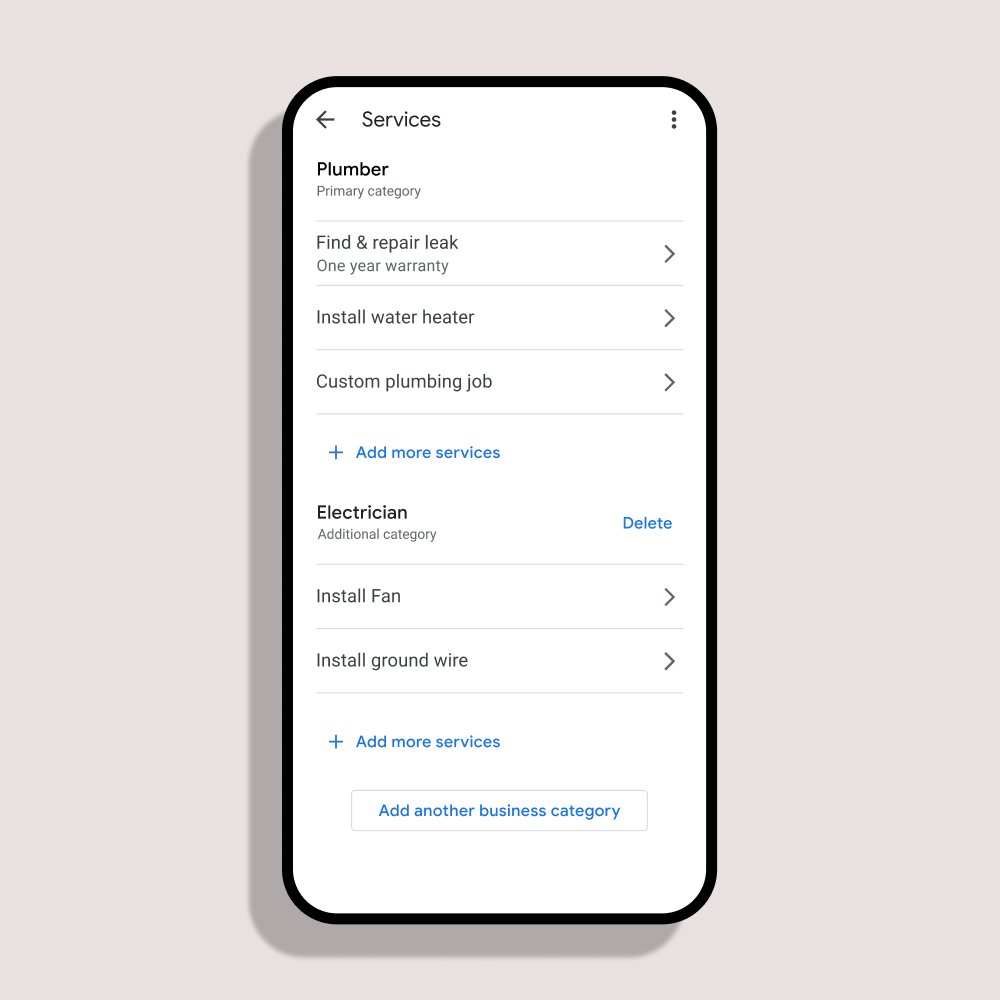
Easily show customers what services you offer from the menu in Search
For those who have a service or restaurant business and work with one of our Reserve with Google partners, you can now enable online bookings through your Business Profile — right from Google Search. Once you’ve signed up with a Reserve with Google partner, you’ll see how many bookings customers have made with your business directly on Google.
Accept takeout and delivery orders
Food ordering on Google has increased more than 230% since last year thanks to a boost in demand (who else is tired of doing dishes?) and new restaurant partners. To help handle the demand, Order with Google lets food businesses accept orders for takeout and delivery directly through their Business Profile on Google Search and Maps. This makes it easier for you to reach new customers and turn searches on Google into orders.
In the coming weeks, you’ll also be able to add and update online ordering options directly from Google Search. Once enabled, you can indicate your ordering preferences for takeout and delivery to let customers know what works best for you.
To help your restaurant stand out on Google, we’ve added easier ways to share your menu. You can now add menu items to your Business Profile on Search and Maps. Simply add and edit your entire menu or featured dishes via the ‘Edit profile’ menu on Search. These new entry points help food businesses update their info and interact with customers right from the apps they already use — Search and Maps.
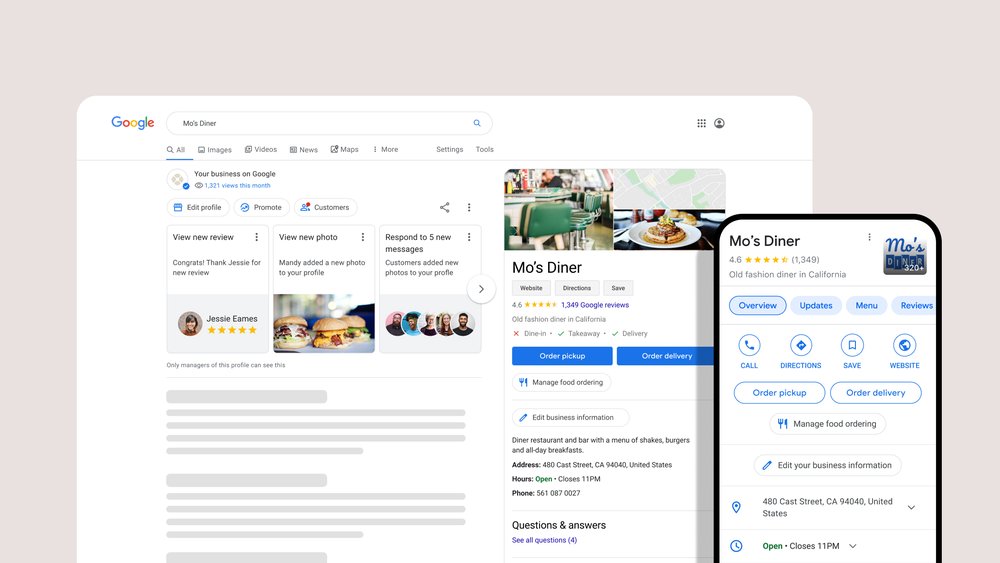
Accept food orders and update your menu to connect with customers on Google
Help customers find the products you sell
Shoppers are increasingly looking for products online before they head to the store. In fact, Google Searches for “who has” + “in stock” have grown by more than 8,000% year over year. In addition to being able to manually add product information to your Business Profile via Search and Maps, eligible retailers in the U.S. can get all their in-store product inventory automatically added to their Business Profile by signing up for Pointy from Google right from Google Search.
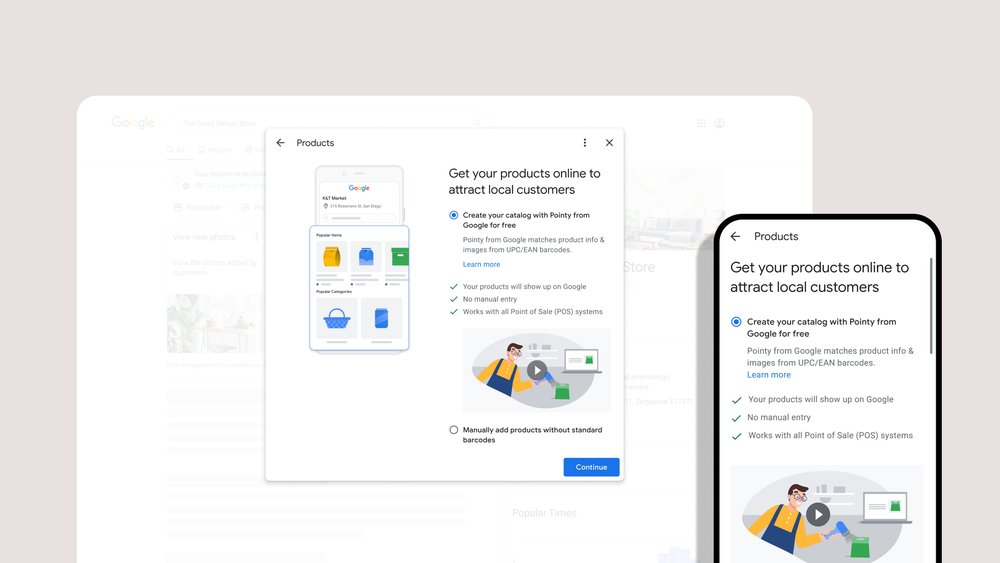
Help customers find the products you sell in-store with Pointy
Pointy removes the work of manually entering product details, which can be especially hard if you sell a lot of products. As you scan items being sold in your store, the products are automatically added to your Business Profile so that potential customers can see what’s currently in stock. Eligible retailers can now get Pointy for free through September 30.*
Keep an eye out for more
We want to help businesses stand out and reach new customers on Google. We’re continuing to find new ways that make it as easy as possible to update your Google presence. Later this summer, business owners who've started their onboarding journey but aren't yet verified will get a taste of this experience too and will be able to complete their verification journey on Search and Maps. Keep an eye out for more details in the coming months!
*Pointy Box supplies are limited and shipping may be delayed. Offer excludes ads.
New tools to support vaccine access and distribution
by Tomer Shekel on Jun.09, 2021, under 3D Models, Argentina, Australia, Brazil, California, Denmark, England, Germany, Google Earth News, Google Earth Tips, Google Sky, Google maps, Hawaii, Indonesia, Ireland, Italy, Japan, Kenya, Mexico, Natural Landmarks, Netherlands, Sightseeing, Street Views, USA
Editor’s note: COVID-19 Vaccination Search Insights is now available. Find the dashboard here.
While over half of U.S. adults are fully vaccinated, vaccine uptake is slowing across the country. Research shows a variety of factors are preventing people from getting vaccinated — from physical access issues, like transportation challenges and not being able to take time off work, to concerns about safety and side effects.
To help public health officials and researchers in the U.S. reach people facing these challenges, we’re introducing new tools to better understand the vaccination needs of a community. This builds on our work of providing data, insights and tools to public health, epidemiologists, researchers and policymakers since the early days of the pandemic.
Equitable access to vaccinations
For some people getting vaccinated is as simple as walking a few blocks to their local pharmacy. For others, it may be much more difficult and involve a long drive or navigating public transit. If public health officials, researchers and healthcare providers can identify areas where vaccination sites are inaccessible or hard to reach, they may be able to implement measures like pop-up vaccine sites or transportation support like ride vouchers.
Our COVID-19 Vaccination Access Dataset, which is available to the public today, calculates travel time to vaccination sites to identify areas where it may be difficult to reach a site whether someone is walking, driving or taking public transportation. We prepared this dataset using Google Maps Platform Directions API, the same API that powers navigation in Google Maps. This dataset does not contain any user data.
This dataset will help power a new Vaccine Equity Plannerdashboard from Ariadne Labs, a joint center for health systems innovation at Brigham & Women’s Hospital and the Harvard T.H. Chan School of Public Health, and Boston Children’s Hospital, the primary pediatric teaching affiliate of Harvard Medical School. This dashboard integrates our dataset with data from other organizations, such as the CDC’s social vulnerability index, to identify “vaccine deserts,” or areas where people have little or no convenient access to a vaccine site, to inform interventions such as pop-up clinics or new sites.
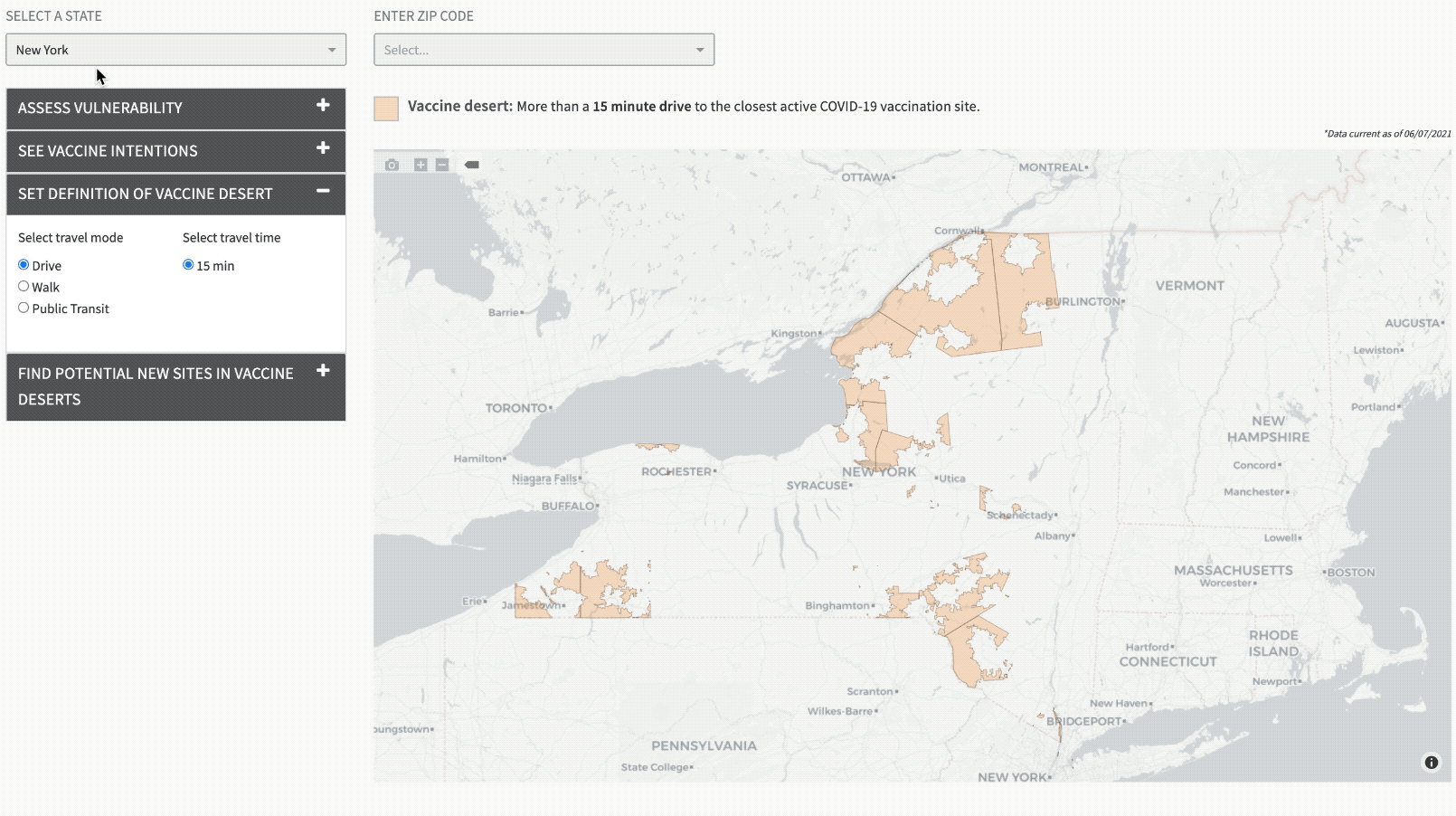
Vaccine Equity Planner dashboard for New York and Mississippi.
Understanding vaccine information needs
Public health organizations have been the go-to sources for authoritative information throughout the pandemic, and have provided educational campaigns about the safety, efficacy and availability of vaccines. We’ve heard from public health organizations and researchers that they want access to localized and timely data about what information their communities are seeking so they can tailor their communication to people not yet vaccinated.
In the coming weeks, we’ll introduce a COVID-19 Vaccination Search Insights tool to help public health officials and researchers explore vaccine-related concerns and the information needs of local communities. The tool will show trends representing the relative search interests across three search categories: all vaccine information, intent to get vaccinated (such as eligibility, availability and sites), and safety and side effects. Insights will be provided at the county and zip code level and updated weekly.
The trends are based on aggregate and anonymized Google Search data so that no user information is included. The process to anonymize the COVID-19 Vaccination Search Insights is powered by differential privacy, a technique that adds noise to the data to provide privacy guarantees while preserving the overall quality of the data. The data can be compared across different regions and over time, without sharing the absolute number of queries in any given area.
Both tools will initially be available in English and for the U.S. As we get more feedback from public health organizations, researchers, and the community at large, we’ll evaluate expanding these tools internationally.
With these insights, we hope that public health organizations and healthcare providers can more easily and effectively reach their communities. Google will continue to do its part by providing timely and accurate vaccine information and appointment availability to people in Search and supporting organizations focused on vaccine equity.
The complete Google guide to summer 2021
by Summer Ime on Jun.03, 2021, under 3D Models, Argentina, Australia, Brazil, California, Denmark, England, Germany, Google Earth News, Google Earth Tips, Google Sky, Google maps, Hawaii, Indonesia, Ireland, Italy, Japan, Kenya, Mexico, Natural Landmarks, Netherlands, Sightseeing, Street Views, USA
The sun is shining, the days are getting longer and more and more U.S. cities are reopening — it’s official, summer 2021 is almost here. Right on time, vacation fever has hit: Google searches for “summer vacation” and “sunscreen” are seeing a major spike, and those are just a couple of the many interesting Google Trends we’ve been seeing. So we decided to collect some of this information to bring you Google’s Guide to Summer: You’ll find trending travel spots, must-eat-at restaurants and tips for finding the perfect summer gear.
To find what places are turning into vacation destinations, we looked at places with the highest percentage growth in hotel searches, comparing April 2021 to April 2019. These 10 cities saw the biggest bump in interest:
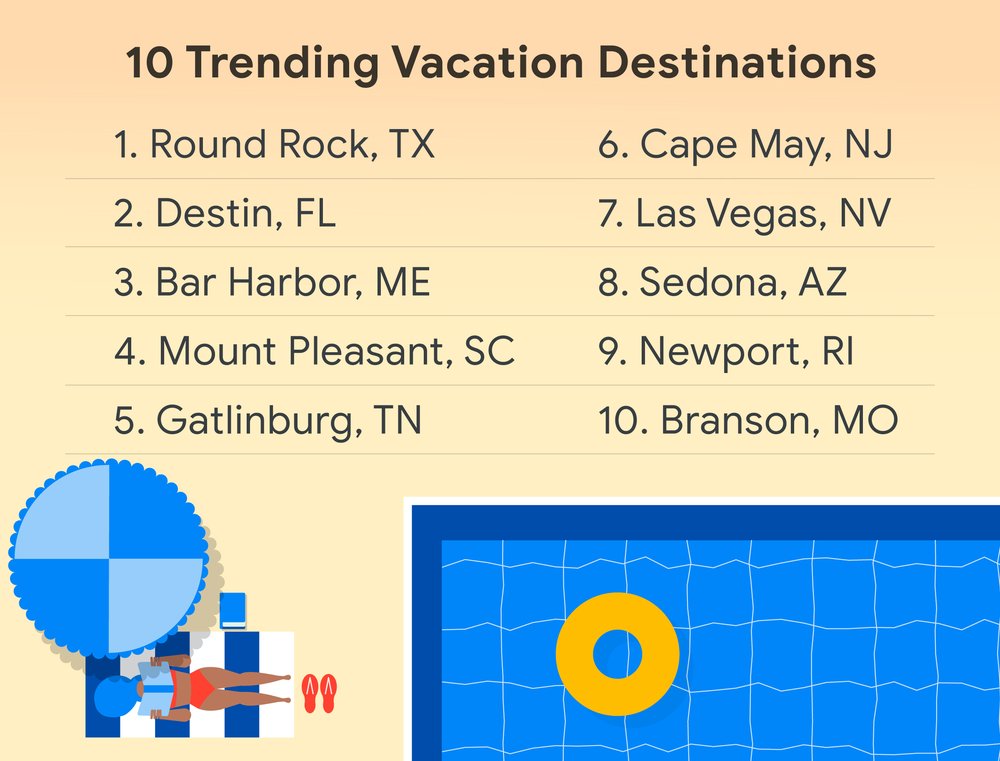
If you’re planning a trip to one of these places, the next step is deciding where to eat while you’re there. Hidden Gem restaurants are verified restaurants on Google Maps with high ratings from fewer people — which could help you avoid crowds and get an amazing meal. Check out these Hidden Gems from each of the cities listed above:
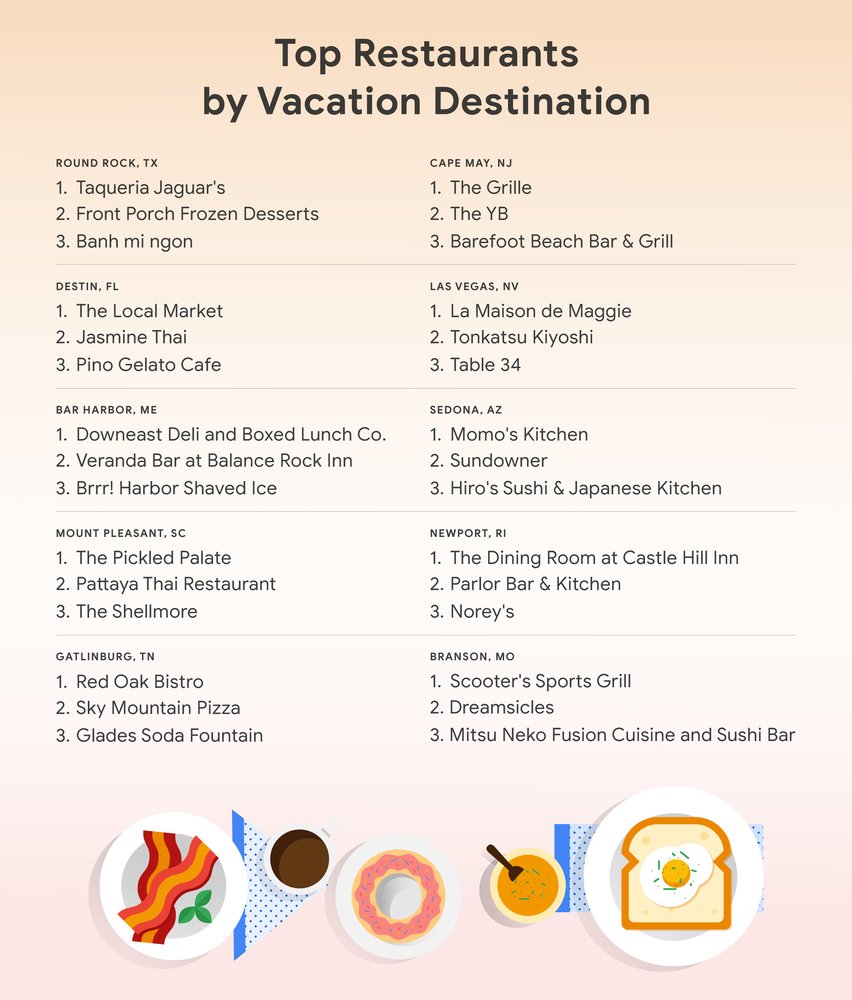
If you’re not ready to travel by plane, you’re not alone. Many people are looking into alternative transportation options or even local options, such as…
The complete Google guide to summer 2021
by Summer Ime on Jun.03, 2021, under 3D Models, Argentina, Australia, Brazil, California, Denmark, England, Germany, Google Earth News, Google Earth Tips, Google Sky, Google maps, Hawaii, Indonesia, Ireland, Italy, Japan, Kenya, Mexico, Natural Landmarks, Netherlands, Sightseeing, Street Views, USA
The sun is shining, the days are getting longer and more and more U.S. cities are reopening — it’s official, summer 2021 is almost here. Right on time, vacation fever has hit: Google searches for “summer vacation” and “sunscreen” are seeing a major spike, and those are just a couple of the many interesting Google Trends we’ve been seeing. So we decided to collect some of this information to bring you Google’s Guide to Summer: You’ll find trending travel spots, must-eat-at restaurants and tips for finding the perfect summer gear.
To find what places are turning into vacation destinations, we looked at places with the highest percentage growth in hotel searches, comparing April 2021 to April 2019. These 10 cities saw the biggest bump in interest:

If you’re planning a trip to one of these places, the next step is deciding where to eat while you’re there. Hidden Gem restaurants are verified restaurants on Google Maps with high ratings from fewer people — which could help you avoid crowds and get an amazing meal. Check out these Hidden Gems from each of the cities listed above:

If you’re not ready to travel by plane, you’re not alone. Many people are looking into alternative transportation options or even local options, such as…
Search, explore and shop the world’s information, powered by AI
by Prabhakar Raghavan on May.19, 2021, under 3D Models, Argentina, Australia, Brazil, California, Denmark, England, Germany, Google Earth News, Google Earth Tips, Google Sky, Google maps, Hawaii, Indonesia, Ireland, Italy, Japan, Kenya, Mexico, Natural Landmarks, Netherlands, Sightseeing, Street Views, USA
AI advancements push the boundaries of what Google products can do. Nowhere is this clearer than at the core of our mission to make information more accessible and useful for everyone.
We've spent more than two decades developing not just a better understanding of information on the web, but a better understanding of the world. Because when we understand information, we can make it more helpful — whether you’re a remote student learning a complex new subject, a caregiver looking for trusted information on COVID vaccines or a parent searching for the best route home.
Deeper understanding with MUM
One of the hardest problems for search engines today is helping you with complex tasks — like planning what to do on a family outing. These often require multiple searches to get the information you need. In fact, we find that it takes people eight searches on average to complete complex tasks.
With a new technology called Multitask Unified Model, or MUM, we're able to better understand much more complex questions and needs, so in the future, it will require fewer searches to get things done. Like BERT, MUM is built on a Transformer architecture, but it’s 1,000 times more powerful and can multitask in order to unlock information in new ways. MUM not only understands language, but also generates it. It’s trained across 75 different languages and many different tasks at once, allowing it to develop a more comprehensive understanding of information and world knowledge than previous models. And MUM is multimodal, so it understands information across text and images and in the future, can expand to more modalities like video and audio.
Imagine a question like: “I’ve hiked Mt. Adams and now want to hike Mt. Fuji next fall, what should I do differently to prepare?” This would stump search engines today, but in the future, MUM could understand this complex task and generate a response, pointing to highly relevant results to dive deeper. We’ve already started internal pilots with MUM and are excited about its potential for improving Google products.
Information comes to life with Lens and AR
People come to Google to learn new things, and visuals can make all the difference. Google Lens lets you search what you see — from your camera, your photos or even your search bar. Today we’re seeing more than 3 billion searches with Lens every month, and an increasingly popular use case is learning. For example, many students might have schoolwork in a language they aren't very familiar with. That’s why we’re updating the Translate filter in Lens so it’s easy to copy, listen to or search translated text, helping students access education content from the web in over 100 languages.

AR is also a powerful tool for visual learning. With the new AR athletes in Search, you can see signature moves from some of your favorite athletes in AR — like Simone Biles’s famous balance beam routine.
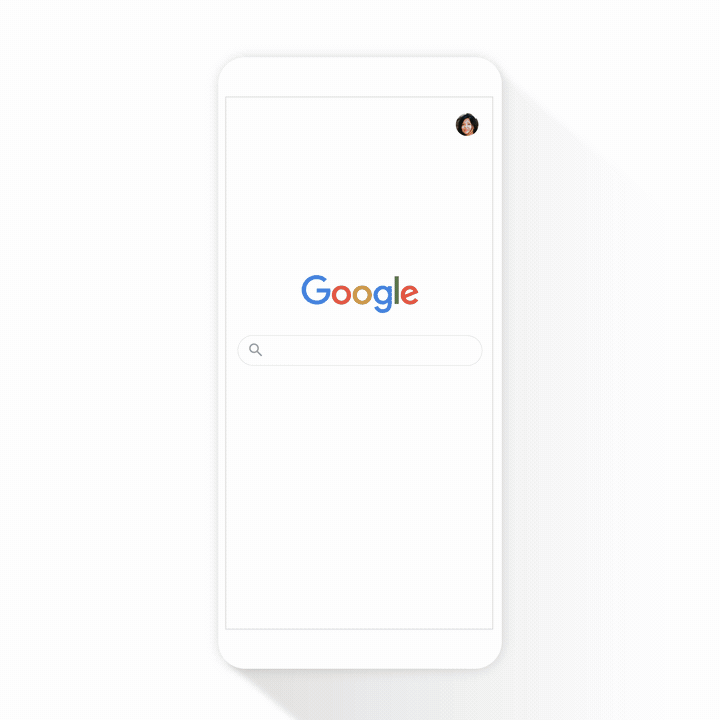
Evaluate information with About This Result
Helpful information should be credible and reliable, and especially during moments like the pandemic or elections, people turn to Google for trustworthy information.
Our ranking systems are designed to prioritize high-quality information, but we also help you evaluate the credibility of sources, right in Google Search. Our About This Result feature provides details about a website before you visit it, including its description, when it was first indexed and whether your connection to the site is secure.
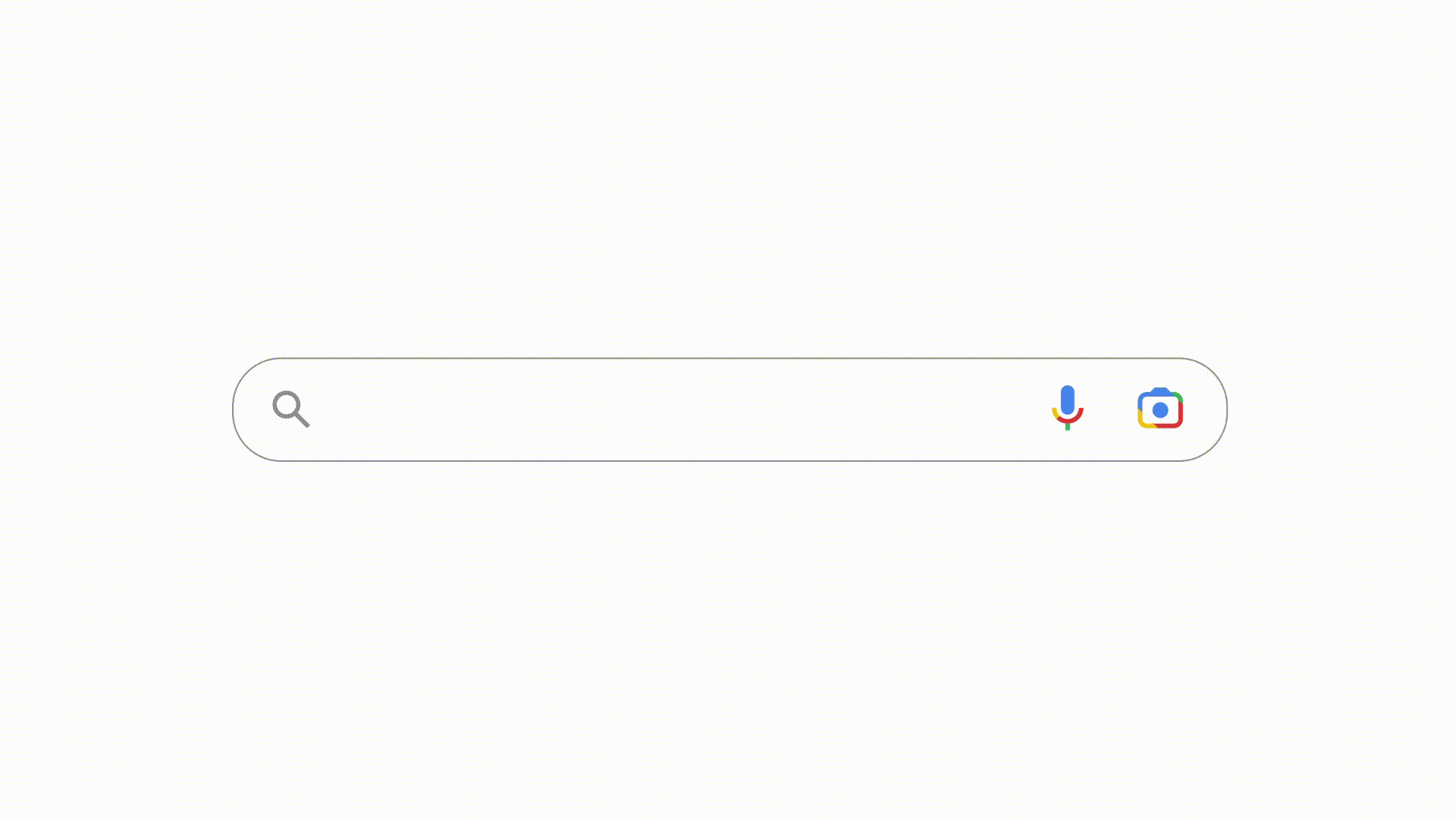
This month, we’ll start rolling out About This Result to all English results worldwide, with more languages to come. Later this year, we’ll add even more detail, like how a site describes itself, what other sources are saying about it and related articles to check out.
Exploring the real world with Maps
Google Maps transformed how people navigate, explore and get things done in the world — and we continue to push the boundaries of what a map can be with industry-first features like AR navigation in Live View at scale. We recently announced we’re on track to launch over 100 AI-powered improvements to Google Maps by the end of year, and today, we’re introducing a few of the newest ones. Our new routing updates are designed to reduce the likelihood of hard-braking on your drive using machine learning and historical navigation information — which we believe could eliminate over 100 million hard-braking events in routes driven with Google Maps each year.
If you’re looking for things to do, our more tailored map will spotlight relevant places based on time of day and whether or not you’re traveling. Enhancements to Live View and detailed street maps will help you explore and get a deep understanding of an area as quickly as possible. And if you want to see how busy neighborhoods and parts of town are, you’ll be able to do this at a glance as soon as you open Maps.
More ways to shop with Google
People are shopping across Google more than a billion times per day, and our AI-enhanced Shopping Graph — our deep understanding of products, sellers, brands, reviews, product information and inventory data — powers many features that help you find exactly what you’re looking for.
Because shopping isn’t always a linear experience, we’re introducing new ways to explore and keep track of products. Now, when you take a screenshot, Google Photos will prompt you to search the photo with Lens, so you can immediately shop for that item if you want. And on Chrome, we’ll help you keep track of shopping carts you’ve begun to fill, so you can easily resume your virtual shopping trip. We're also working with retailers to surface loyalty benefits for customers earlier, to help inform their decisions.
Last year we made it free for merchants to sell their products on Google. Now, we’re introducing a new, simplified process that helps Shopify’s 1.7 million merchants make their products discoverable across Google in just a few clicks.
Whether we’re understanding the world’s information, or helping you understand it too, we’re dedicated to making our products more useful every day. And with the power of AI, no matter how complex your task, we’ll be able to bring you the highest quality, most relevant results.
Looking for something?
Use the form below to search the site:
Still not finding what you're looking for? Drop a comment on a post or contact us so we can take care of it!
Visit our friends!
A few highly recommended friends...
Archives
All entries, chronologically...